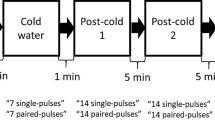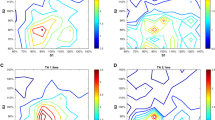Abstract
The effect of the short-acting benzodiazepine lorazepam on motor cortex excitability was investigated in 11 healthy volunteers using the technique of focal transcranial magnetic stimulation. The threshold intensity for evoking an electromyographic response in the resting and active abductor digiti minimi muscle, the size of the motor evoked potential, the duration of the cortical and peripheral silent periods, the corticocortical inhibition and facilitation after paired magnetic stimuli, and the transcallosal inhibition were used as parameters to assess various aspects of motor system excitability. Baseline values were compared with data obtained 2, 5 and 24 h after a single oral dose of 2.5 mg lorazepam. Resting and active motor thresholds and the size of the motor evoked potential remained unchanged. The duration of the cortical silent period was prolonged with a maximum effect 5 h after drug intake, while the peripheral silent period did not show any lengthening at that time. The corticocortical inhibition showed a tendency toward more inhibition, while the corticocortical facilitation was almost completely suppressed. The transcallosal inhibition showed an inconsistent trend to less inhibition. In parallel to the pharmacokinetics of lorazepam, all effects peaked at 2 h and 5 h, and were (partially) reversible after 24 h. It is hypothesized that most of these findings are due to the reinforcement of GABA action by lorazepam at the level of the motor cortex. The lack of effect on motor threshold and on the size of the motor evoked potential may indicate that these parameters are physiologically distinct from corticocortical excitability and the cortical silent period. The relevance of the present data in clinical epileptology is discussed.
Similar content being viewed by others
References
Abadie P, Baron JC, Bisserbe JC, Boulenger JP, Rioux P, Travère JM, Barré L, Petit-Taboué MC, Zarifian E (1992) Central benzodiazepine receptors in human brain: estimation of regional Bmax and KD values with positron emission tomography. Eur J Pharmacol 213:107–115
Amassian VE, Quirk GJ, Stewart M (1990) A comparison of corticospinal activation by magnetic coil and electrical stimulation of monkey motor cortex. Electroencephalogr Clin Neurophysiol 77:390–401
Asanuma H, Okuda O (1962) Effects of transcallosal volleys on pyramidal tract cell activity of cat. J Neurophysiol 25:198–208
Baker SN, Olivier E, Lemon RN (1994) Recording an identified pyramidal volley evoked by transcranial magnetic stimulation in a conscious macaque monkey. Exp Brain Res 98:128–134
Barker AT, Jalinous R, Freeston IE (1985) Non-invasive magnetic stimulation of human motor cortex. Eancet 1:1106–1107
Brasil-Neto JP, Cohen EG, Panizza M, Nilsson J, Roth BJ, Hallett M (1992) Optimal focal transcranial magnetic activation of the human motor cortex: effects of coil orientation, shape of the induced current pulse, and stimulus intensity. J Clin Neurophysiol 9:132–136
Cantello R, Gianelli M, Bettucci D, Civardi C, De Angelis MS, Mutani R (1991) Parkinson's disease rigidity: magnetic motor evoked potentials in a small hand muscle. Neurology 41:1449–1456
Cantello R, Gianelli M, Civardi C, Mutani R (1992) Magnetic brain stimulation: the silent period after the motor evoked potential. Neurology 42:1951–1959
Cracco RQ, Amassian VE, Maccabee PJ, Cracco JB (1989) Comparison of human transcallosal responses evoked by magnetic coil and electrical stimulation. Electroencephalogr Clin Neurophysiol 74:417–424
Crook JM, Eysel U (1992) GABA-induced inactivation of functionally characterized sites in cat visual cortex (area 18): effects on orientation tuning. J Neurosci 12:1816–1825
Day BE, Dressler D, Maertens De Noordhout A, Marsden CD, Nakashima K, Rothwell JC, Thompson PD (1989) Electric and magnetic stimulation of human motor cortex: surface EMG and single motor unit responses. J Physiol (Lond) 412:449–473
Edgley S, Eyre JA, Lemon RN, Miller S (1990) Excitation of the corticospinal tract by electomagnetic and electrical stimulation of the scalp in the macaque monkey. J Physiol (Lond) 425:301–320
Engel J Jr (1989) Seizures and epilepsy. Davis, Philadelphia
Faull RLM, Villinger JW (1986) Benzodiazepine receptors in the human spinal cord: a detailed anatomical and pharmacological study. Neuroscience 17:791–802
Ferbert A, Priori A, Rothwell JC, Day BE, Colebatch JG, Marsden CD (1992) Interhemispheric inhibition of the human motor cortex. J Physiol (Lond) 453:525–546
Fuhr P, Agostino R, Hallett M (1991) Spinal motor neuron excitability during the silent period after cortical stimulation. Electroencephalogr Clin Neurophysiol 81:257–262
Giesen HJ von, Roick J, Benecke R (1994) Inhibitory actions of motor cortex following unilateral brain lesions as studied by magnetic brain stimulation. Exp Brain Res 99:84–96
Haug BA, Kukowski B (1994) Eatency and duration of the muscle silent period following transcranial magnetic stimulation in multiple sclerosis, cerebral ischemia, and other upper motoneuron lesions. Neurology 44:936–940
Hufnagel A, Elger CE, Marx W, Ising A (1990) Magnetic motorevoked potentials in epilepsy: effects of the disease and of anticonvulsant medication. Ann Neurol 28:680–686
Inghilleri M, Beradelli A, Cruccu G, Manfredi M (1993) Silent period evoked by transcranial stimulation of the human cortex and cervicomedullary junction. J Physiol (Lond) 466:521–534
Knowles JA, Comer WH, Ruelius HW (1971) Disposition of 7chloro-5-(0-chlorophenyl)-1,3-dihydro-3-hydroxy-2ITH-1,4benzodizepin-2-one (lorazepam) in humans. Drug Res 21:1055–1059
Kofler M, Saltuari L, Schmutzhard E, Berek K, Baumgartner J, Russegger L, Aichner F (1992) Electrophysiological findings in a case of severe intrathecal baclofen overdose. Electroencephalogr Clin Neurophysiol 83:83–86
Kujirai T, Caramia MD, Rothwell JC, Day BL, Thompson PD, Ferbert A, Wroe S, Asselman P, Marsden CD (1993) Corticocortical inhibition in human motor cortex. J Physiol (Lond) 471:501–519
Matsumara M, Sawaguchi T, Kubota K (1992) GABAergic inhibition of neuronal activity in the primate motor and premotor cortex during voluntary movement. J Neurophysiol 68:692–702
Mavroudakis N, Caroyer JM, Brunko E, Zegers de Beyl D (1994) Effects of diphenylhydantoin on motor potentials evoked with magnetic stimulation. Electroencephalogr Clin Neurophysiol 93:428–433
Netz J, Ziemann U, Hömberg V (1995) Hemispheric asymmetry of transcallosal inhibition in man. Exp Brain Res 104:527–533
Olsen RW (1987) The γ-aminobutyric acid/benzodiazepine/barbiturate receptor-chloride ion channel complex of mammalian brain. In: Edelman GM, Gall WE, Cowan WM (eds) Synaptic function. Wiley, Chichester, NY, pp 257–271
Priori A, Beradelli A, Inghilleri M, Polidori L, Manfredi M (1994a) Electromyographic silent period after transcranial brain stimulation in Huntington's disease. Mov Disord 9:178–182
Priori A, Beradelli A, Inghilleri M, Accornero N, Manfredi M (1994b) Motor cortical inhibition and the dopaminergic system. Pharmacological changes in the silent period after transcranial brain stimulation in normal subjects, patients with Parkinson's disease and drug-induced parkinsonism. Brain 117:317–323
Reutens DC, Berkovic SF, Macdonell RAL, Bladin PF (1993) Magnetic stimulation of the brain in generalized epilepsy: reversal of cortical hyperexcitability by anticonvulsants. Ann Neurol 34:351–355
Ridding MC, Inzelberg R, Rothwell JC (1995) Changes in excitability of motor cortical circuitry in patients with Parkinsons's disease. Ann Neurol 37:181–188
Roick H, von Giesen HJ, Benecke R (1993) On the origin of the postexcitatory inhibition seen after transcranial magnetic brain stimulation in awake human subjects. Exp Brain Res 94:489–498
Schönle PW, Isenberg C, Crozier TA, Dressler D, Machetanz J, Conrad B (1989) Changes of transcranially evoked motor responses in man by midazolam, a short acting benzodiazepine. Neurosci Lett 101:321–324
Sillito AM (1975) The contribution of inhibitory mechanisms to the receptive field properties of neurones in the striate cortex of the cat. J Physiol (Lond) 250:305–329
Terao Y, Hayashi H, Shimizu T, Tanabe H, Hanajima R, Ugawa Y (1995) Altered motor cortical excitability to magnetic stimulation in a patient with a lesion in globus pallidus. J Neurol Sci 129:175–178
Ugawa Y, Hanajima R, Kanazawa I (1993) Interhemispheric facilitation of the hand area of the human motor cortex. Neurosci Lett 160:153–155
Valls-Solé J, Pascual-Leone A, Brasil-Neto JP, Cammarota A, McShane L, Hallett M (1994) Abnormal facilitation of the response to transcranial magnetic stimulation in patients with Parkinson's disease. Neurology 44:735–741
Waldvogel HJ, Faull RLM, Jansen KLR, Dragunow M, Richards JG, Mohler H, Streit (1990) GABA, GABA receptors and benzodiazepine receptors in the human spinal cord: an autoradiographic and immunohistochemical study at the light and electron microscopic levels. Neuroscience 39:361–385
Werhahn KJ, Fong JKY, Meyer B-U, Priori A, Rothwell JC, Day BL, Thompson PD (1994) The effect of magnetic coil orientation on the latency of surface EMG and single motor unit responses in the first dorsal interosseus muscle. Electroencephalogr Clin Neurophysiol 93:138–146
Wilson SA, Lockwood RJ, Thickbroom GW, Mastaglia FL (1993) The muscle silent period following transcranial magnetic cortical stimulation. J Neurol Sci 114:216–222
Ziemann U, Netz J, Szelényi A, Hömberg V (1993) Spinal and supraspinal mechanisms contribute to the silent period in the contracting soleus muscle after transcranial magnetic stimulation of human motor cortex. Neurosci Lett 156:167–171
Ziemann U, Lönnecker S, Paulus W (1995) Inhibition of human motor cortex by ethanol: a transcranial magnetic stimulation study. Brain 118:1437–1446
Author information
Authors and Affiliations
Rights and permissions
About this article
Cite this article
Ziemann, U., Lönnecker, S., Steinhoff, B.J. et al. The effect of lorazepam on the motor cortical excitability in man. Exp Brain Res 109, 127–135 (1996). https://doi.org/10.1007/BF00228633
Received:
Accepted:
Issue Date:
DOI: https://doi.org/10.1007/BF00228633




